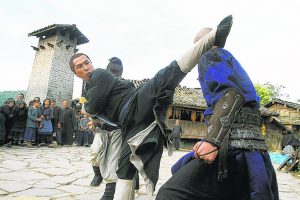Art of Wuxia Design Guidelines, Part 3 Tropes

Before beginning work on Art of Wuxia I developed a list of things that I wanted out of the game. Before every writing session and play test session, I take that list out and read it. My rule is that the list must absolutely be followed to keep the design of the game focused on its most important parts. The next few articles will cover this list and explain why I feel each of these guidelines was important for Art of Wuxia.
The tropes in wuxia are very strong. I’ll write another article on wuxia tropes later on but for now I’ll focus on my design guideline list.
Design Guideline: Anything can be used as a weapon. I have seen everything used as a weapon in wuxia movies and TV shows and the books are even more over the top. Built right into the weapons table in Art of Wuxia are improvised weapons. So if you can imagine using something as a weapon, you can.
Design Guideline: Unarmed attacks should be almost as good as armed attacks. Heroes in wuxia tales are usually as good with their fists as they are with their swords. The same thing is true in Art of Wuxia There are certain cases where having a weapon is better than not having one but it isn’t overwhelmingly so. One of the kung fu styles in the game doesn’t even teach weapons.
Design Guideline: Armor needs to be limited. Nearly every hero you see in wuxia stories doesn’t wear armor or if they do it is something light. You’ll still find armor in Art of Wuxia but the damage reduction it offers is variable, and it is expensive. Unarmed peasants (minor NPCs) don’t stand a chance against armored troops (minor NPCs). But if they have some heroes defending them…
Design Guideline: There should be a poser turn. I’ve talked about this one before. It is a favorite at my game table and at the convention games I’ve run. Just as in wuxia movies and TV series occasionally the heroes pose and the camera zooms in on them at a dramatic moment, so too this will happen in your game. It is a moment where the action pauses and something cool to help the PCs happens before the next turn begins.
Design Guideline: Adventures should include love and vengeance. Here is where the wuxia genre really departs from traditional fantasy. I can’t think of a wuxia story where these two elements weren’t a key plot element. The GM is encouraged (if the players are up for it) to provide romantic entanglements for the PCs to get involved with. These come with plot complications (he’s the son of the governor and she’s an outlaw) and can lead to further adventures. This is not forced on anyone and is an option if you really want to embrace the genre. After each adventure the GM goes over a checklist to see if anyone will seek vengeance for some slight, or harm caused by the PCs. Beware murder hobos! Beware!
Design Guideline: There should be wuxia examples and quotes. To help players and GMs get into the wuxia genre we are putting quotes by famous NPCs in the book. The quotes are designed to reinforce the tropes of wuxia and possibly give GMs adventure ideas. We’ve also listed examples of what spells look like for that wuxia feel and even specifically spells cast by certain sorcerer sects.
These guidelines were created to help ensure that wuxia tropes would be integrated into the rules. Yes, there is a list of wuxia tropes in the introduction but that would be useless if they weren’t reinforced throughout the rest of the book. Tropes can be shown with NPCs, items, skills etc. but the rules or “game verbs” of the book need to solidly support them.
You can see how strong the tropes of the wuxia genre are for yourself. Go to the Downloads page, download, and print the wuxia bingo cards. Then play wuxia bingo with friends while watching a wuxia movie. Remember to yell “WUXIA!” when you win.
